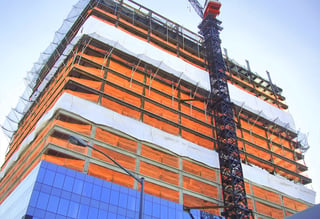Construction and industrial jobsites are busy environments where safety and efficiency are paramount. Maintaining a secure site is managing the risk of falling debris, tools, or materials. This is where debris netting comes into play. Debris netting serves multiple purposes, including protecting workers and passersby from potential injuries, containing or catching falling objects, and sometimes even providing a degree of weather protection. Let's dive into some of the types of debris netting available and understand when and why each type is best used.
DEBRIS NETTING

Debris netting is the most common type found on construction sites. Made from lightweight, durable materials like polyethylene or polypropylene, it's designed to catch small debris, such as pebbles, bits of concrete, and small tools. This netting is often used around the perimeter of scaffolding or building sites to prevent objects from falling outside the work area, thus protecting pedestrians and equipment below.
Debris netting mesh comes in various sizes, like 1/4" or 1/16". Choosing between the type—or any specialized variant like heavy-duty debris netting, personnel safety nets, or pour-in-place netting—depends on specific project needs, the nature of the work environment, and the primary objectives for netting use.
Best Use: Ideal for urban construction sites or renovations where the risk to the public is a concern, but it's a versatile safety measure that can apply to many jobsites and many applications like guardrails, floor-to-ceiling netting, or even event and stage fencing . It's also beneficial for internal site demarcation.
Benefits: Easy to install and dismantle, cost-effective, and provides a breathable barrier that minimizes dust and debris escape while allowing air and light to pass through.
Heavy-Duty Debris Netting
 As the name suggests, heavy-duty debris netting is designed for more demanding environments where larger, heavier items pose a falling risk. It is made from stronger materials, often with reinforced edges and increased UV protection, to withstand harsher conditions and heavier loads.
As the name suggests, heavy-duty debris netting is designed for more demanding environments where larger, heavier items pose a falling risk. It is made from stronger materials, often with reinforced edges and increased UV protection, to withstand harsher conditions and heavier loads.
Best Use: Perfect for high-rise construction, demolition sites, bridge construction or maintenance, industrial plants or refineries, offshore oil platforms, and areas where heavy materials are moved overhead.
Benefits: Provides enhanced durability and load-bearing capacity, reducing the risk of tears or breaks under weight. It also offers extended longevity, even in harsh weather.
Personnel Safety Nets
 Personnel safety nets are designed to catch falling workers or objects, making them essential to high-rises or any construction where falling objects at height are a concern. These nets must meet rigorous safety standards and are often made from high-strength materials with a tighter mesh to cushion falls effectively or capture dropped objects efficiently.
Personnel safety nets are designed to catch falling workers or objects, making them essential to high-rises or any construction where falling objects at height are a concern. These nets must meet rigorous safety standards and are often made from high-strength materials with a tighter mesh to cushion falls effectively or capture dropped objects efficiently.
Best Use: Essential for construction sites with significant heights where the risk of falls is high. They are often used alongside other fall protection measures like harnesses and guardrails. It's also great for marine ship repair, bridge construction, and tunnel or highway overpass construction.
Benefits: Significantly reduces the risk of injury from falls, providing a safety net (literally) for workers. It also helps in compliance with safety regulations and enhances worker confidence in safety measures.
Pour-in-Place Netting
 Pour-in-place netting is specialized for use during concrete pouring operations. It's designed to catch tools or debris during the pouring process or while an open hole is waiting for duct or electrical work to be completed.
Pour-in-place netting is specialized for use during concrete pouring operations. It's designed to catch tools or debris during the pouring process or while an open hole is waiting for duct or electrical work to be completed.
Best Use: Ideal for sites where concrete work is extensive along stairways, elevator shafts, or duct openings.
Benefits: It's an easy-to-install and remove, cost-effective dropped object and prevention measure. Helps maintain a clean and safe work environment, reduces material wastage, and ensures dropped objects dont' affect underlying work areas or equipment.
Dropped Object Mats
 Dropped object mats are not netting per se but are included here for their similar application in catching and minimizing the impact of falling objects. These mats are placed on the ground or over sensitive areas to prevent tools or objects from falling and can also help prevent damage or injury due to objects falling from a height.
Dropped object mats are not netting per se but are included here for their similar application in catching and minimizing the impact of falling objects. These mats are placed on the ground or over sensitive areas to prevent tools or objects from falling and can also help prevent damage or injury due to objects falling from a height.
Best Use: They are suitable for use as a temporary work mat underneath areas where work is being conducted at height, mainly where heavy tools or materials are used. They are also used to protect sensitive equipment or surfaces.
Benefits: An easy-to-deploy, fold, and reuse safety measure that provides an additional layer of protection against dropped objects.
Conclusion
Choosing the right type of debris netting or protective matting for a construction or industrial jobsite is crucial for ensuring safety, regulatory compliance, and operational efficiency. Each type of netting has its specific applications and benefits, making it important to assess the jobsite's needs carefully. Implementing these protective measures not only safeguards workers and the public but also contributes to a smoother, more secure project execution.
These are only a few of the netting options Eagle Industries offers. To see our full line of debris and safety netting solutions, check out our website.